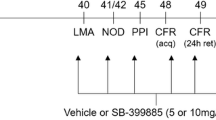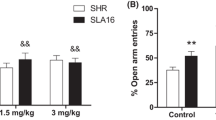Abstract
To investigate whether isolation rearing alters 5-hydroxytryptamine2C (5-HT2C) receptors, the effect of the serotonin agonistm-chlorophenylpiperazine (mCPP) was examined on elevated plus-maze behaviour, plasma corticosterone and brain 5-HT2C receptor protein levels in rats. There was no distinction between behaviour or corticosterone levels in drug-free isolates or socially housed rats exposed to the elevated plus-maze. The anxiogenic response tomCPP (decrease in open arm entry and time and an increase in stretch attend postures) on the elevated plus-maze was greater in isolation than in socially reared controls without any concomitant difference in the hypolocomotor effect ofmCPP in the two groups.mCPP produced a greater elevation in plasma corticosterone in isolates than in group-housed controls. Hippocampal 5-HT2C receptor protein-like immunoreactive levels were significantly lower followingmCPP than saline only in rats reared in isolation. These results indicate that increased 5-HT2C receptor responsiveness accompanies isolation-rearing and may contribute to the enhanced response to stress and the increased neophobia seen in this animal model of trait anxiety/depression. In isolation reared rats, rapid down-regulation of supersensitive 5-HT2C receptors may occur in the hippocampus following 5-HT agonist challenge.
Similar content being viewed by others
References
Beckett S, Marsden CA (1995) Computer analysis and quantification of periaqueductal grey-induced defence behaviour. J Neurosci Methods 58:157–161
Bickerdike MJ, Wright IA, Marsden CA (1993) Social isolation attenuates rat forebrain 5-HT release induced by KC1 stimulation and exposure to a novel environment. Behav Pharmacol 4:231–236
Chaouloff F (1993) Physiopharmacological interactions between stress hormones and central serotonergic systems. Brain Res Rev 18:1–32
Einon DF, Morgan MJ (1978) Early social isolation produces' enduring hyperactivity in the rat, but no effect on spontaneous alteration. Q J Exp Psychol 30:151–156
File SE, Velluchi SV (1978) Studies on the role of ACTH and of 5-HT in anxiety, using an animal model. J Pharm Pharmacol 30:105–110
File SE, Zangrossi H, Sanders FL, Mabbutt PS (1994) Raised corticosterone in the rat after exposure to the elevated plus-maze. Psychopharmacology 113:543–546
Fulford AJ, Butler S, Heal DJ, Kendall DA, Marsden CA (1994) Evidence for altered a2-adrenoceptor function following isolation-rearing in the rat. Psychopharmacology 116:183–190
Gentsch C, Lichtsteiner M, Feer H (1981) Locomotor activity, defecation score and corticosterone levels during an openfield exposure: a comparison among individually and group-housed rats, and gentically selected rat lines. Physiol Behav 27:183–186
Gibson EL, Barnfield AMC, Curzon G (1994) Evidence thatmCPP-induced anxiety in the plus-maze is mediated by post-synaptic 5-HT2C receptors but not by sympathomimetic effects. Neuropharmacology 33:457–465
Greco AM, Gambadella P, Sticchi R, D'Aponte D, Di Renzo G, De Franciscis P (1989) Effect of individual housing on circadian rhythms of adult rats. Physiol Behav 45:363–366
Greenough WT, Madden TC, Fleischmann TB (1972) Effect of isolation, daily handling and enriched rearing on maze learning. Psychon Sci 27:279–280
Holson RR, Scallet AC, Ali SF, Turner BB (1991) “Isolation stress” revisited: isolation-rearing effects depend on animal care methods. Physiol Behav 49:1107–1118
Jones GH, Marsden CA, Robbins TW (1989) Isolation-rearing retards the acquisition opf schedule-induced polydipsia in rats. Physiol Behav 45:71–78
Jones GH, Marsden CA, Robbins TW (1990) Increased sensitivity to amphetamine and reward-related stimuli following social isolation in rats; possible disruption of dopamine dependent mechanisms of nucleus accumbens. Psychopharmacology 102:364–372
Juraska JM, Henderson C, Muller J (1984) Differential rearing experience, gender and radial maze performance. Dev Psychobiol 17:209–215
Kalen P, Rosengren E, Lindvall O, Bjorklund A (1989) Hippocampal noradrenaline and serotonin release over 24 hours as measured by the dialysis technique in freely moving rats: correlation to behavioural activity state, effect of handling and tail pinch. Eur J Neurosci 1:181–186
Kennett GA (1992) 5-HT1C receptor antagonists have anxiolytic-like actions in the rat social interaction model. Psychopharmacology 107:379–384
Kennett GA, Curzon G (1988) Evidence thatmCPP may have behavioural effects mediated by central 5-HT1C receptors. Br J Pharmacol 94:137–147
Kennett GA, Bailey F, Piper DC, Blackburn TP (1995) Effect of SB 200646A, a 5-HT2C5-HT2B receptor antagonist, in 2 conflict models of anxiety. Psychopharmacology 118:178–182
Parker V, Morinan A (1986) The socially-isolated rat as a model for anxiety. Neuropharmacology 25:663–664
Rocha B, Rigo M, Di SG, Sandner G, Hoyer D (1994) Chronic mianserin or eltoprazine treatment in rats: effects on the elevated plus-maze test and on limbic 5-HT2C receptor levels. Eur J Pharmacol 262:125–131
Sahakian BJ, Robbins TW, Morgan MJ, Iversen SD (1975) The effects of psychomotor stimulants on stereotypy and locomotor activity in socially deprived and control rats. Brain Res 84:195–205
Sharma A, Topham IA, Fone KCF (1994) Effect of the 5,7-dihydroxytryptamine on 5-HT2C receptor protein-like immunoreactivity in the rat brain and spinal cord. Br J Pharmacol 111:150P
Shepherd JK, Grewal SS, Fletcher A, Bill DJ, Dourish CT (1994) Behavioural and pharmacological characterisation of the elevated “zero-maze” as an animal model of anxiety. Psychopharmacology 116:56–64
Walsh RN, Cummins RA (1976) The open field test: a critical review. Psychol Bull 83:482–504
Whitton P, Curzon G (1990) Anxiogenic-like effect of infusing 1-(3-chlorophenyl)piperazine (mCPP) into the hippocampus. Psychopharmacology 100:138–140
Wright IK, Ismail H, Upton N, Marsden CA (1991a) Effect of isolation rearing on 5-HT agonist-induced responses in the rat. Psychopharmacology 105:259–263
Wright IK, Upton N, Marsden CA (1991b) Resocialisation of isolation-reared rats does not alter the anxiogenic profile on the elevated x-maze model of anxiety. Physiol Behav 50:1129–1132
Wright IA, Upton N, Marsden CA (1992) Effect of established and putative anxiolytics on extracellular 5-HT and 5-HIAA in the ventral hippocampus of rats during behaviour on the elevated X-maze. Psychopharmacology 109:338–346
Author information
Authors and Affiliations
Rights and permissions
About this article
Cite this article
Fone, K.C.F., Shalders, K., Fox, Z.D. et al. Increased 5-HT2C receptor responsiveness occurs on rearing rats in social isolation. Psychopharmacology 123, 346–352 (1996). https://doi.org/10.1007/BF02246645
Received:
Revised:
Issue Date:
DOI: https://doi.org/10.1007/BF02246645




